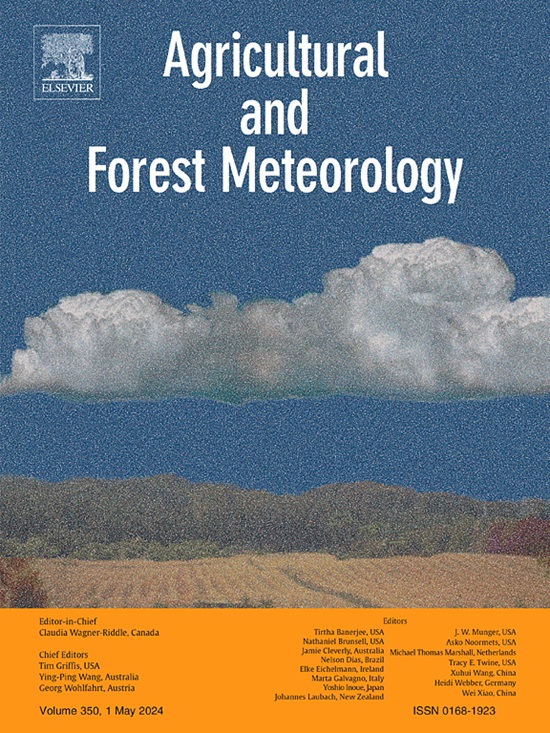Current and future cropland suitability for cereal production across the rainfed agricultural landscapes of Ethiopia
IF 5.6
1区 农林科学
Q1 AGRONOMY
引用次数: 0
Abstract
One of the major challenges posed by climate change in agriculture is the alteration in cropland suitability. This alteration has serious consequences for food security and economic stability at global, regional, and local scales, especially in smallholder and rainfed agricultural systems like in Ethiopia. A comprehensive understanding of the current state of croplands and future changes under warming temperatures and increasing rainfall uncertainty is critical for national climate adaptation planning. Here, we evaluated cropland suitability (CLS) for four major cereal crops (teff, maize, sorghum, and wheat), under both current and future climates across the rainfed agriculture (RFA) landscapes of Ethiopia. We utilized a novel suitability modelling approach that establishes functional relationships between crop yield, and climatic factors (rainfall, temperature, and solar radiation) and soil factors (texture, pH, and organic carbon). Furthermore, we analyzed the relative influences of the growing season rainfall and temperature on the changes in CLS. The results show that 54 % of the RFA area has a suitability index of 0.6 or higher (moderately to highly suitable) for teff and that 51 %, 63 %, and 29 % of the grid cells are suitable for maize, sorghum, and wheat crops, respectively. The suitable agroecologies of the four crops will likely undergo altitudinal shifts and areal contraction, with magnitudes of the changes depending on the emission scenarios. Under the SSP2–4.5, the suitable areas are projected to decrease by 25 % for teff, 7 % for maize, 10 % for sorghum, and 16 % for wheat in the 2080s. In semi-arid and hyper-humid climates, CLS is sensitive to changes in the growing season rainfall, whereas in low and high elevation regions, it is temperature-sensitive. In light of our results, we argue that adaptation actions tailored to agroecological conditions and topographic locations are vitally necessary to mitigate the long-term impacts of climate change on Ethiopia's rainfed agriculture.
埃塞俄比亚雨水灌溉农业区当前和未来谷物生产的耕地适宜性
气候变化给农业带来的主要挑战之一是耕地适宜性的改变。这种变化对全球、区域和地方范围内的粮食安全和经济稳定造成严重后果,尤其是在埃塞俄比亚这样的小农和雨水灌溉农业系统中。全面了解耕地的现状以及在气温升高和降雨量不确定性增加的情况下耕地的未来变化对于国家气候适应规划至关重要。在此,我们评估了埃塞俄比亚雨养农业(RFA)景观中四种主要谷物作物(teff、玉米、高粱和小麦)在当前和未来气候条件下的耕地适宜性(CLS)。我们采用了一种新颖的适宜性建模方法,在作物产量、气候因子(降雨、温度和太阳辐射)和土壤因子(质地、pH 值和有机碳)之间建立了函数关系。此外,我们还分析了生长季降雨量和温度对 CLS 变化的相对影响。结果表明,54% 的区域渔业局区域适合种植非洲茶的指数为 0.6 或更高(中度到高度适合),分别有 51%、63% 和 29% 的网格单元适合种植玉米、高粱和小麦作物。四种作物的适宜农业生态可能会发生海拔移动和面积收缩,变化幅度取决于排放情景。在 SSP2-4.5 情景下,预计到 2080 年代,非洲茶叶的适宜面积将减少 25%,玉米减少 7%,高粱减少 10%,小麦减少 16%。在半干旱和超湿润气候条件下,CLS 对生长季降雨量的变化非常敏感,而在低海拔和高海拔地区,CLS 对温度非常敏感。根据我们的研究结果,我们认为必须采取适合农业生态条件和地形的适应行动,以减轻气候变化对埃塞俄比亚雨养农业的长期影响。
本文章由计算机程序翻译,如有差异,请以英文原文为准。
求助全文
约1分钟内获得全文
求助全文
来源期刊
CiteScore
10.30
自引率
9.70%
发文量
415
审稿时长
69 days
期刊介绍:
Agricultural and Forest Meteorology is an international journal for the publication of original articles and reviews on the inter-relationship between meteorology, agriculture, forestry, and natural ecosystems. Emphasis is on basic and applied scientific research relevant to practical problems in the field of plant and soil sciences, ecology and biogeochemistry as affected by weather as well as climate variability and change. Theoretical models should be tested against experimental data. Articles must appeal to an international audience. Special issues devoted to single topics are also published.
Typical topics include canopy micrometeorology (e.g. canopy radiation transfer, turbulence near the ground, evapotranspiration, energy balance, fluxes of trace gases), micrometeorological instrumentation (e.g., sensors for trace gases, flux measurement instruments, radiation measurement techniques), aerobiology (e.g. the dispersion of pollen, spores, insects and pesticides), biometeorology (e.g. the effect of weather and climate on plant distribution, crop yield, water-use efficiency, and plant phenology), forest-fire/weather interactions, and feedbacks from vegetation to weather and the climate system.

 求助内容:
求助内容: 应助结果提醒方式:
应助结果提醒方式:


